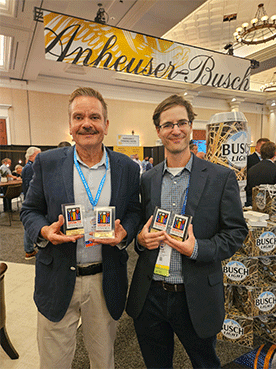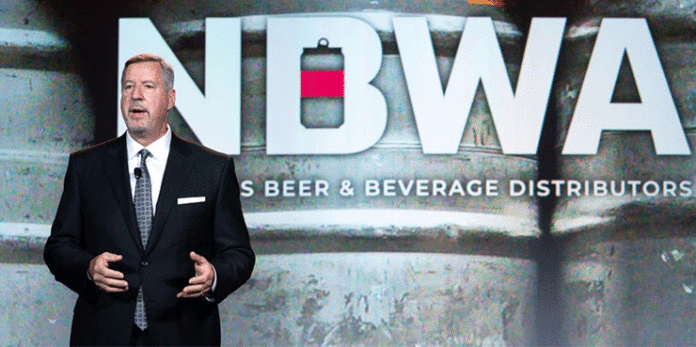The U.S. beer industry remains in a state of uncertainty and transition, as old staples shrink and new opportunities emerge, in line with shifting consumer tastes. Such was the picture painted by the 86th Annual National Beer Wholesalers Association Convention and Trade Show, which occurred this October at Caesar’s Palace in Las Vegas.
Around 2,600 beer distributors and industry stakeholders from across the country descended upon the sparkling desert city for the multi-day event. Outgoing Chairman of the Board Gordon Green opened his remarks by addressing the Bud Light-shaped elephant in the room.
“The challenges of the nation’s largest beer brand have directly and seriously impacted many of our distributor businesses and employees,” Green said. “Attacks in the media, threats against employees and workplace safety challenges have shaken our industry to its core. And even those of us who don’t carry that brand have also been affected as we face a decline in beer’s slice of the alcohol beverage pie.”
“All of this is happening against the backdrop of ongoing pressure from suppliers, including terminations without cause, big soda’s continued entry into alcohol, the expansion of the canned cocktail spirits category, constant attacks on the three-tier system and the changing preferences of our consumers,” he added.

These observations, that beer faces significant issues beyond the Bud Light/Dylan Mulvaney marketing fiasco, remained the central theme throughout the conference. Incoming Chairman Jim Fabiano listed additional issues in his remarks.
“Liquor continues to see growth, with Ready-To-Drink canned spirits gaining shelf space and popularity,” Fabiano said. “Distillers seek to capitalize on these trends by upending decades of bipartisan consensus on the clear differences between beer, wine and liquor. Now I know none of us are afraid of some honest competition. But let me ask you a question: Why should liquor in a can be taxed differently than liquor in a glass? Thanks to the NBWA, that message is reverberating throughout federal and state legislatures.”
“Nor do everyday people want their mail carrier to be in charge of maintaining public health, yet that is exactly what is being proposed across the country through direct-to-consumer bills, which undermine the legal foundations of our three-tier system,” he added later in his speech. “It sometimes feels like a bad game of Whac-A-Mole, the way these bills keep popping up and we fight to push them down. Fortunately, federal efforts have been stopped in their tracks thanks to NBWA’s work to educate policymakers on these flawed proposals. NBWA’s team continues to deliver political victories for our industry – like keeping anti-competitive tax provisions out of last year’s Inflation Reduction Act.”
Fabiano was among many speakers who stressed the need for beer wholesalers to collaborate and fight against forces now pressuring the industry. Much praise was directed this way towards the successful and ongoing legislative efforts by NBWA and its Political Action Committee (PAC).
Another common observation was that the “core beer” portfolio, while in decline, still represented the foundation of a wholesaler’s business. A survey conducted among conference attendees found that “core beer” currently represented 80% of their overall portfolio. However, five years from now, attendees believed that that number would shrink to 70%.
“That’s still a big number; that’s still keeping the lights on,” said Shannon McQuade-Ely, of McQuade Distributing in North Dakota, during a panel on the future of beer distribution. Nevertheless, in recapturing the attention of younger drinkers who have increasingly turned to other categories, “It’s very important for us to look at beer as brand,” she added. “And for that we need to ask for help from the producers and retailers.

McQuade-Ely mentioned her work with the NBWA’s Beer First Initiative, which provides data and promotional materials meant to showcase the value of beer. Tools include sell sheets that can be customized for every market, and on- and off-premise profit calculators to show accounts and retailers how beer can be more profitable than other alcohol options. Throughout this summer, the Beer First Initiative rolled out new resources to participating distributors, with the aim of continually boosting the beer category.
Opportunities for growth, many speakers and vendors believed, will come in the form of occasion-based consumption. As younger LDA drinkers consume less alcohol, grabbing their attention may be a matter of tying a product into a certain part of their regular routine. Hence why many products in the vendor hall had branding focused on the gym, the golf course, the beach or other specific occasions.
“Beer is the drink of getting together with friends and family, and when you’re at a BBQ or a ballgame, most people are reaching for an ice-cold beer,” Green said. “But we cannot be complacent as other alcohol beverages continue to gain market share. We all need to be laser focused on bringing the category back to growth for all of our portfolios.”
Echoing this sentiment was Lester Jones, NBWA Vice President, Analytics and Chief Economist. During his economic briefing — beyond explaining the resiliency of the U.S. economy post-Covid — Jones shared data that suggested that the number of active beer drinkers in America had actually increased slightly since 2012.
“There are absolutely more drinkers in the market today,” Jones said. “There may be less frequency and less volume, but the market is there. Consumers are here and willing. We just have to convince them that beer is the right choice. We have to focus on the occasion. We’re occasion-driven.”

Another potential threat to the middle tier comes in the form of global drinks giants like Coca-Cola launching their own alcohol brands. What if these conglomerates, with their own distribution infrastructure, decide to distribute these new products?
Perhaps to assuage these concerns, the NBWA welcomed on stage to speak Dan White, Coca-Cola North America’s Chief of New Revenue Streams. Beyond the company’s massively successful Jack Daniel’s & Coca-Cola RTD collaboration with Brown-Forman last year, Coca-Cola this summer created its own alcohol division, Red Tree.
“We have no plans to distribute,” White assured attendees. “We picked the lane that we do best. We’re here to develop unique products and unique brands and bring them to market. We’re not here to crash the party. We think we can help drive growth for everybody in the room.”
It was a moment of optimism among messaging at NBWA 2023 that ranged from cautious alarm to a calling of arms to reassurance about the future.
As Fabiano assumed the chairmanship, he shared a sunny outlook. “The thing about challenging times — they create opportunities,” he said. “We have the opportunity before us to build a sturdy, dynamic future for beverage distribution.”
“The way beer brings people of all backgrounds together to enjoy one of life’s simple pleasures — my friends, that will never change,” he added. “As we embrace innovative products as part of our beverage portfolio, we must never lose sight of the unique value that beer brings to our distributorships. And we must all continue to do our part to bring the next generation of legal age drinkers along for the ride.”









